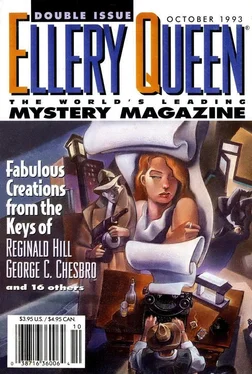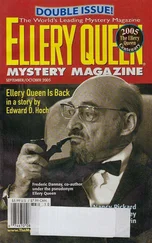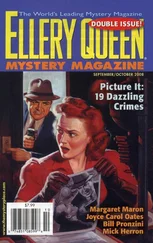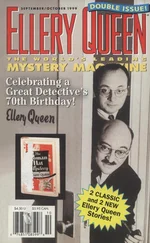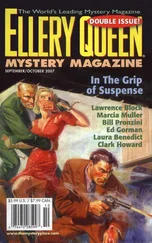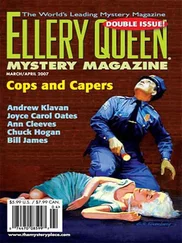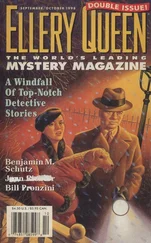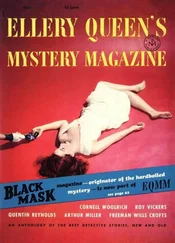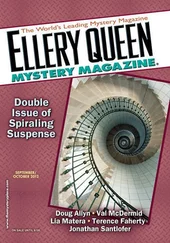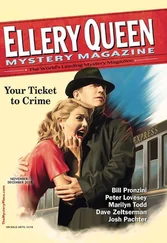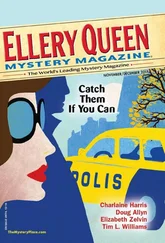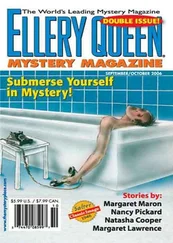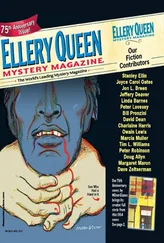Charles Ardai - Ellery Queen’s Mystery Magazine. Vol. 102, No. 4 & 5. Whole No. 618 & 619, October 1993
Здесь есть возможность читать онлайн «Charles Ardai - Ellery Queen’s Mystery Magazine. Vol. 102, No. 4 & 5. Whole No. 618 & 619, October 1993» весь текст электронной книги совершенно бесплатно (целиком полную версию без сокращений). В некоторых случаях можно слушать аудио, скачать через торрент в формате fb2 и присутствует краткое содержание. Город: New York, Год выпуска: 1993, Издательство: Davis Publications, Жанр: Детектив, на английском языке. Описание произведения, (предисловие) а так же отзывы посетителей доступны на портале библиотеки ЛибКат.
- Название:Ellery Queen’s Mystery Magazine. Vol. 102, No. 4 & 5. Whole No. 618 & 619, October 1993
- Автор:
- Издательство:Davis Publications
- Жанр:
- Год:1993
- Город:New York
- ISBN:нет данных
- Рейтинг книги:3 / 5. Голосов: 1
-
Избранное:Добавить в избранное
- Отзывы:
-
Ваша оценка:
- 60
- 1
- 2
- 3
- 4
- 5
Ellery Queen’s Mystery Magazine. Vol. 102, No. 4 & 5. Whole No. 618 & 619, October 1993: краткое содержание, описание и аннотация
Предлагаем к чтению аннотацию, описание, краткое содержание или предисловие (зависит от того, что написал сам автор книги «Ellery Queen’s Mystery Magazine. Vol. 102, No. 4 & 5. Whole No. 618 & 619, October 1993»). Если вы не нашли необходимую информацию о книге — напишите в комментариях, мы постараемся отыскать её.
Ellery Queen’s Mystery Magazine. Vol. 102, No. 4 & 5. Whole No. 618 & 619, October 1993 — читать онлайн бесплатно полную книгу (весь текст) целиком
Ниже представлен текст книги, разбитый по страницам. Система сохранения места последней прочитанной страницы, позволяет с удобством читать онлайн бесплатно книгу «Ellery Queen’s Mystery Magazine. Vol. 102, No. 4 & 5. Whole No. 618 & 619, October 1993», без необходимости каждый раз заново искать на чём Вы остановились. Поставьте закладку, и сможете в любой момент перейти на страницу, на которой закончили чтение.
Интервал:
Закладка:
I remember going over to the small room where the damning broken sculpture remained, guiltily showing the world the tiny crack through which Leifcrown had fallen along with his talent. I questioned Henry Moreland’s judgment, but the family of our late genius had agreed to let the sculpture be shown. After all, the circumstances surrounding his death were widely known, in part because of me.
The bronze piece stood there as if it had no regrets.
Then I smelled the peppermint odor. It was unlike anything I knew, a piquant faint suggestion of camphor. A man next to me looked worried. He recognized me.
“Phenol,” he said with a hint of accusation in his voice.
So it finally happened: the discovery of the body of a teenaged girl inside the piece, and the sculpture bashing that ensued. Literally. All of Leifcrown’s works were ripped apart.
There were maybe twelve bodies in all, some limbs or organs appearing in this or that sculpture. Certainly not every bronze by Leifcrown was an urn, they were the least, but his work was tainted. His monumental works, notably “Broken Hands,” were tom down hastily and melted away.
The police were able to piece together the image of a “classic” serial murderer, whatever that is. They found incriminating bits and pieces in his studio which had been overlooked while they were only investigating the suicide of an artist, thinking that suicide is the proper exit for eccentrics like Leifcrown. They solved a good number of mysterious disappearances, missing persons reports that were answered by the contents of so many heretofore beautiful pieces, although they are still trying to figure out his M.O.
I really don’t care about that. What he did, he did. We purport to believe that a man’s work must be separated from his personal life, but that is hard to do in Leifcrown’s case. No one has even tried to defend the artistic value of his sculptures since.
But I do care what we are to do, we, those of us who praised Leifcrown, who helped him rise to fame and fortune. What are we to think about any work of art from this day on? Can we ever forgive ourselves?
But perhaps there is nothing to forgive. We can only regret our words. Regret his work. Regret the world that bore Conrad Leifcrown. And wonder...

All in the Eyes
by Barbara Owens
© 1993 by Barbara Owens
San Jose, California resident Barbara Owens is becoming one of our most regular and dependable contributors. This time she weaves a sinister tale of what the media nowadays calls “elderly abuse...”
Mrs. Hucklebee collects things. Not fine crystal, burnished copper, or brass; not antique dolls, elaborate thimbles, or quaint salt and pepper shakers. All are easily obtainable within her city, but such items do not strike a responsive chord in this lady’s individualistic heart.
No, Mrs. Hucklebee is drawn to the ordinary. Everyday things that flick by at vision’s edge, easily overlooked — like wedding announcements in the newspaper. A regular weekend highlight is the clipping of these announcements, careful scrutiny of each smiling face, and then the verdict: an inked X in the picture’s upper right-hand comer — red if the couple will live together long and faithfully, black if their future is doomed by death, divorce, or who can tell. Then placement into a scrapbook, its predecessors lining shelves along one living room wall, and Mrs. Hucklebee sits back, satisfied.
“It’s in the eyes,” she always announces aloud. “All in the eyes.”
The opposite wall shelves contain her dried-leaf scrapbooks, each specimen carefully preserved under plastic wrap, and recently she’s embarked upon a new and exciting accumulation. Already jelly, pickle, and mayonnaise jars soldier the window sills, holding clear-colored glass marbles like those used in flower arrangements. Mrs. Hucklebee loves to sit watching little rainbows slide slowly across the room.
However, it’s a leaf that absorbs her on this sharp bright October day. She has discovered it while walking home from the pharmacy, and when she spies a neighbor in the park Mrs. Hucklebee can’t resist sharing her good fortune. Joining the younger woman on the bench, she unwraps the leaf from its pocket tissue, gently stroking its golden face.
“Look at that. See how coppery the veins are?”
“A beauty,” Mrs. Gambrelli responds warmly. “What a fine one for your collection.”
While Mrs. Hucklebee folds the leaf back into its protective tissue, Mrs. Gambrelli says, “One of the last of the season, I’m afraid. Winter’s knocking. Sometimes I worry about you, Mrs. Hucklebee, alone in that big house. You call if you ever need anything, you understand?”
Mrs. Hucklebee smiles tolerantly. Mrs. Gambrelli is new to the neighborhood.
“Don’t you worry about me, dear. Mr. Hucklebee’s been gone so long I’m used to being on my own.”
Suddenly a wail sounds. Little Joey has swooped down the playground slide and landed hard. Before Mrs. Gambrelli can move a figure appears, scoops up the boy, and trots toward the bench, whispering close against his ear. When Joey is deposited into his mother’s lap he’s sunny again.
“Thank you,” Mrs. Gambrelli says, cuddling her son to her breast. “Where did you come from so fast?”
The figure is that of a young girl, scarcely more than a child herself. Thin-faced, with dark ragged hair, she wears worn jeans and a dirty windbreaker that seems too light for such a chilly day. As Mrs. Hucklebee looks up at her the girl’s brown eyes pass slowly across her face.
“I could use a dollar,” she says to Mrs. Gambrelli.
Mrs. Gambrelli looks flustered. “Oh, I’m sorry. I haven’t brought my purse.”
Magnanimously, Mrs. Hucklebee opens her own. “Here.” She presses a bill into the girl’s small cold hand. “Get a cup of hot chocolate. Aren’t you cold in that little jacket? You should go home and put on something warm.”
The girl murmurs, “Thanks.” Before turning away, she studies Mrs. Hucklebee’s face again. The women watch her walk away and disappear into a tangle of shrubbery nearby.
“Sad to see children begging on the streets,” Mrs. Gambrelli says, tightening her hold on Joey.
Mrs. Hucklebee has already forgotten the girl. She’s gazing fondly at her house on the comer across the boulevard — dark and tall, a high stone wall enclosing its backyard. She is unaware of its slightly shabby appearance, a darkening tooth in the street’s otherwise pleasant smile. Mrs. Hucklebee’s home is her haven. It holds all her treasures.
She stands up abruptly. “So nice talking to you, Mrs. Gambrelli. I must go and see to my new leaf.”
She hurries across the boulevard, eager, not feeling the eyes that follow her all the way home.
With winter approaching, dusk lowers earlier each day. By the time the golden leaf is shrouded in plastic and placed inside a scrapbook the lights are on, glowing valiantly in cavernous old rooms, dimmed by dark wainscoting and faded wallpaper. Mrs. Hucklebee hums in her kitchen while chicken pops and fizzles in a black iron skillet and the aroma of baking banana bread wafts into the far recesses of the house.
The doorbell stirs her from her complacency. In the feeble pool cast by the porch light the girl from the park smiles at her through the screen.
“I’m hungry,” she says in a small clear voice. “You’re so nice I know you’ll want to give me something to eat. I’ll work for it. Is that fried chicken I smell?”
Читать дальшеИнтервал:
Закладка:
Похожие книги на «Ellery Queen’s Mystery Magazine. Vol. 102, No. 4 & 5. Whole No. 618 & 619, October 1993»
Представляем Вашему вниманию похожие книги на «Ellery Queen’s Mystery Magazine. Vol. 102, No. 4 & 5. Whole No. 618 & 619, October 1993» списком для выбора. Мы отобрали схожую по названию и смыслу литературу в надежде предоставить читателям больше вариантов отыскать новые, интересные, ещё непрочитанные произведения.
Обсуждение, отзывы о книге «Ellery Queen’s Mystery Magazine. Vol. 102, No. 4 & 5. Whole No. 618 & 619, October 1993» и просто собственные мнения читателей. Оставьте ваши комментарии, напишите, что Вы думаете о произведении, его смысле или главных героях. Укажите что конкретно понравилось, а что нет, и почему Вы так считаете.
